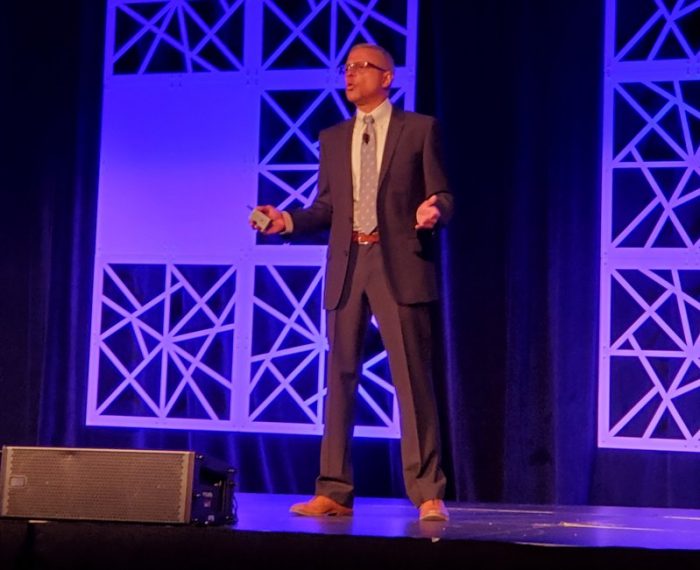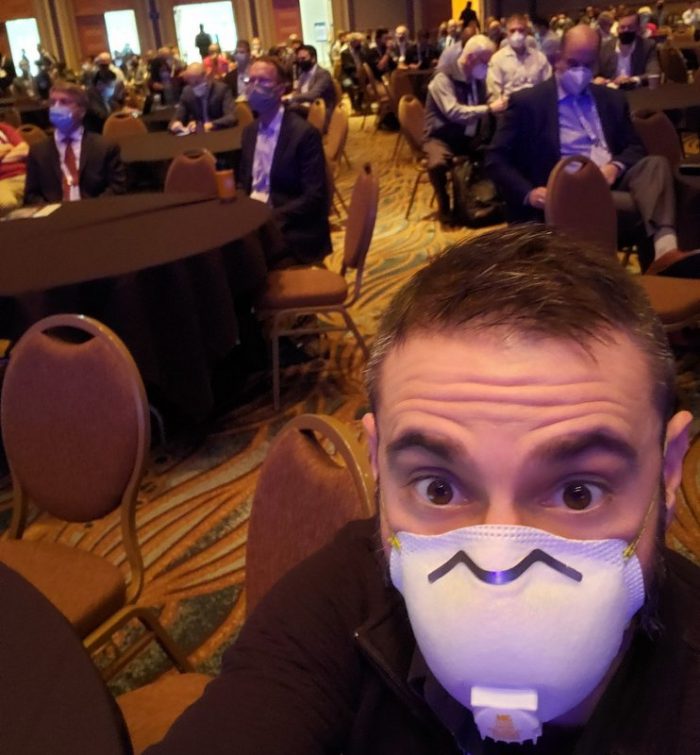Live at Intersolar: The gravity of solving climate change

Intersolar North America and Energy Storage North America are actually happening this week in Long Beach, Calif. – yes, the first industry-wide solar trade show since Intersolar 2020. The attendees aren’t exactly packed in here as they were in pre-pandemic times, but the big ideas and optimism certainly are.
That optimism must come, of course, with a dose of reality to start. That came from lead off keynote Surya Panditi, CEO of Enel X North America, which has about 50 projects in California right now and does a variety of things, notably in mobile energy storage.
He reminds that:
- 2021 hit the 6th highest overall temperature since we started keeping records.
- Climate disasters have caused over $2 trillion in losses since 2000.
How do we start to make a serious dent? Panditi points to the telecom industry, his former industry, which was moving from a much more centralized architecture to a decentralized architecture.
“At the time there was concern from the centralized view is the people participating in that ecosystem would stand to lose if somehow the distributed technologies got more common,” he said. “Things like streaming. Our phones in our pocket. There was concern with the centralized businesses that they would lose control over the outcomes their customers were expecting and therefore would start to see their profits start to drop.”
But then three things came together:
- The policy framework to help everyone take advantage.
- The end points got more reliable and cost effective all the way to our phones.
- We went from a centralized “walled garden” to all of us having the ability to personalize our own experience.
“My personal prediction is we’ll start to see something similar in energy business,” he said. “I started my speech with the dire warnings of climate change, but I have to tell you I’m actually an optimist, and the reason I am is I believe all of us working together can bring together the same kind of three principles that will help us in our business.”
Again:
- The right kind of policy framework.
- The right technology – like, software that has a view of the entire network to orchestrate them in right way, to bring them to market and to bring them to the supply/demand equilibrium that’s needed.
- Right financial structures in the markets we participate in.
One heavy solution

One very cool, big, optimistic idea that can tie a lot of sustainability / decarbonization goals together is long-duration, gravitational energy storage – generating energy to lift heavy thing (stored potential energy), and then dropping that heavy thing (kinetic energy) when needed. We’ve covered this emerging space only a wee bit so far because it seemed so experimental — but Energy Vault is really close, as president John Jung explained in the second keynote address.
Maybe it was just the first-conference-in-two-years enthusiasm, but Energy Vault feels different. Jung noted the company has bagged some serious VC funding and is nearing the launch of its IPO. All of that is cool, but Energy Vault is the first gravitational tech company that’s made it past the seed stage.
Energy Vault actually has a project in the ground in Switzerland that’s demonstrated over 75 percent roundtrip efficiency (!). But what really got me is their fully sustainability story, which goes well beyond providing energy storage capacity, addressing:
• Decommissioned wind blades
• Coal combustion residuals.
• A mining sector in need of transformation
Wind blades. There will be an estimated 9 million tons of decommissioned wind blades laying around by 2039. Recycling here, as with PV panels, is an issue, and Energy Vault’s gravitational storage can recycle the fiber of those blades as part of its design.
Coal residuals. When a coal plant shuts down, an angel gets its wings. But the coal residuals remain, Jung notes. One billion tons of coal residuals will be in remediation, on the ground and on the balance sheet of owners and investors (boo hoo, I know). Those good for nothing residuals can now be incorporated into the 30 to 35 ton slabs that Energy Vault is raising and dropping.
(These gravitational mass blocks can also consist of the dirt dug up on the site for the system itself).
Mining. Large mining companies typical consume 200 million gallons of diesel per year. They also have a lot of land in the middle of nowhere and can easily accommodate the modular design developed by Energy Vault.
“The investors, operators, owners of these systems are able to achieve a better power purchase agreement contract because they are able to offer firm power,” Jung said. “ … if you’re a grid operator, if you have the ability to access electricity that’s firmer, and also kind of like the baseload generation that you had before, it’s a lot easier.”
EVX is Energy Vault’s 2.0 product that includes utility feedback that will make the overall system easier to permit and will be much more modular and scalable than its predecessor.
It’s a cool story and concept at least – energy storage that counteracts the waste of mining rather than requiring even more of it. These are the bolder, interconnected ideas needed to really get us out of this mess and to our global decarbonization goals. Even if I never hear from Energy Vault again, it felt good to be here in Long Beach, in the room, hearing the presentation, feeling the energy, thinking big, and believing stuff is possible and actually happening out here.





Comments are closed here.